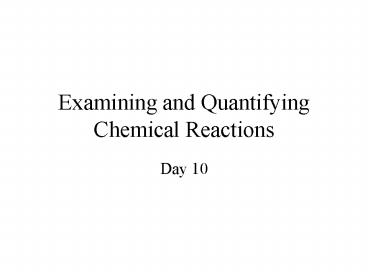Examining and Quantifying Chemical Reactions - PowerPoint PPT Presentation
1 / 25
Title: Examining and Quantifying Chemical Reactions
1
Examining and Quantifying Chemical Reactions
- Day 10
2
Chemical Equations
- Chemical change involves a reorganization of the
atoms in one or more substances.
3
The Hindenburg Reaction
- Reactants are on left, products to the right.
- Arrow indicates the change
4
A chemical equation
- Notice that the formula for the molecules is
unchanged. - To indicate that more than one molecule is
required, use coefficients (shown in blue). - The equation is balanced.
- 2 H2 O2 ? 2 H2O
5
The Rules
- Change only the coefficients to balance the
chemical equation. - Balance one element at a time.
- Continue to balance the other elements in the
same manner. - Adjust coefficients to the lowest whole number
common multiple. - Check your answers.
6
Example
- FeI2 Cl2 ? FeCl3 I2
7
(No Transcript)
8
Balancing Combustion Reactions
- Balance carbon first
- Hydrogen second
- Oxygen last
- Multiply by 2 if you need to.
- ___ C3H8 ___ O2 ? ___ CO2 ___ H2O
9
More Balancing and Things to Avoid
- ___ C3H8 ___ O2 ? ___ CO2 ___ H2O
- Coefficients should always have the lowest whole
number ratio. - Never Change the subscripts. 8 CO2 is not the
same as C8O16. - ___ CH4 ___ O2 ? ___ CO2 ___ H2O
10
A Pictorial Representation
more help
11
Quantifying Chemical Reactions
12
The mole (6.02 x 1023)
- A macroscopic version of the molecule defined so
we can use the periodic table for the macroscopic
and microscopic world. - Defined as the number of atoms in exactly 12.0 g
of carbon-12 isotope. - This is number is called Avogadros Number after
the Italian physicist Amedeo Avogadro
(1776-1856).
13
How Big is a Mole
14
Formula Weight
- The sum of the atomic weights of all the atoms in
the molecular formula, whether ionic or
molecular. - Expressed in amu/molecule or grams/mole.
- Also called molecular weight, molar mass
15
Example
- What is the molecular weight of Urea, (NH2)2CO (a
molecular substance)? - Solution
- 2 x N 2 x 14.0067 28.0134
- 1 x C 1 x 12.0111 12.0111
- 4 x H 4 x 1.00794 4.03176
- 1 x O 1 x 15.9994 15.9994
- TOTAL 60.0556 amu/molecule
- OR
- 60.0556 g/mole
16
Two major conversion factors
- Avagadros number inter-converts the microscopic
and macroscopic worlds - formula weight inter-converts grams and moles.
17
A silly problem
- How many molecules are in one drop (0.0500 g) of
water? (4.25 b)
18
Weight relationships in reactions
- Stoichiometry - Study of the mass relationship
between reactants and product in chemical
reactions. - Always start with a balanced chemical equation!
- Convert grams of A to moles of A. (Use FW)
- Convert moles of A to moles of B. (Use Eq.)
- Convert moles of B to grams of B. (Use FW)
19
Stoichiometry
Grams of other reactant required OR Grams product
formed
Grams of one reactant
X
Step 1. Use the Formula Weight
Step 3. Use the Formula Weight
Moles of other reactant required OR Moles product
formed
Moles of reactant
Step 2. Use the Balanced Equation
20
How many grams of CO2 are produced from the
combustion of 12 grams of CH4?
CH4 2 O2 ? CO2 2 H2O
bal eq
moles
A three step process
fw
fw
grams
12.0 g
21
How much Al is required to react with 55.0 g of
Fe2O3? (Thermite)
Fe2O3 (s) 2 Al (s) ? Al2O3 (s) 2 Fe (l)
22
Describing phases
- (s) solid
- (l) liquid
- (g) gas
- (aq) aqueous (dissolved in water)
23
Types of reactions
24
Reactions in Water (Aqueous)
- In water, when ionic compounds dissolve, they
dissociate into their anions and cations. - It is the polarity of water that allows them to
do this. - Some compounds are soluble and others are not.
- Water is very stable
25
Ionic compounds in water




























